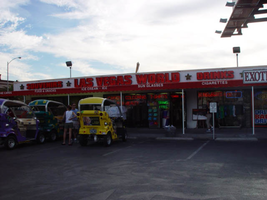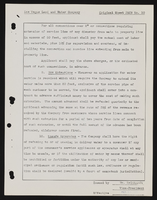Search the Special Collections and Archives Portal
Search Results
Maggie Mancuso Collection of Film Locations
Identifier
Abstract
The Maggie Mancuso Collection of Film Locations dates from 1994 to 2001 and consists primarily of color photographs of locations throughout Las Vegas, Nevada for the film
Archival Collection
Johnny Eshow Haig Papers
Identifier
Abstract
The Johnny Eshow Haig Papers (1970-1990) are comprised of contracts, agreements, and correspondence of musician Johnny Haig, who worked as a trombone player and conductor at various hotels in Las Vegas, Nevada from 1955 until 2000. Additionally, the papers house extensive original music scores written by Haig. The papers primarily cover Haig’s later career in the 1970s and 1980s.
Archival Collection
Beverly Rogers Collection of Armed Services Editions
Identifier
Abstract
The Beverly Rogers Collection of Armed Services Editions includes one thousand two hundred and seventy-nine of the original paperback Armed Services Edition titles published between 1943 and 1947 used by World War II service members in the United States Army and Navy, as well as four editions from the Legacy Project published in 2003 and one from the Pocket Books Inc. series published in 1944. The original Armed Services Editions include works of fiction and non-fiction in their unabridged forms.
Archival Collection
Fort Mojave Indian School Records
Identifier
Abstract
The Fort Mojave Indian School Records (1890-1923) consist of correspondence, finance and administrative records, pump station blueprints, and policy implementation and fact finding records. The school served the Hualapai and Mojave Indians at a site near present-day Kingman, Arizona. The information is contained in two bound volumes.
Archival Collection
Roger D. Foley Papers on United States v. Cappaert
Identifier
Abstract
The Roger D. Foley Papers on United States v. Cappaert are comprised of materials collected by District Judge Roger D. Foley while performing his duties as judge in
Archival Collection
Larry Ruvo oral history interview
Identifier
Abstract
Oral history interview with Larry Ruvo conducted by David G. Schwartz on January 27, 2009 for the Remembering Jay Sarno Oral History Project. Ruvo begins by discussing his position as a front desk clerk at Caesar’s Palace in Las Vegas, Nevada in the 1970s. Ruvo then describes how Jay Sarno changed the casino industry by designing Caesar’s Palace with a single theme. Ruvo then chronicles how gaming gradually was legalized in more areas throughout the world and how Sarno capitalized on making Caesar’s Palace an iconic casino which made people want to travel to Las Vegas. Lastly, Ruvo discusses Sarno’s focus on offering both gaming and entertainment options for guests at Caesar's Palace.
Archival Collection
Celesta Lowe oral history interview
Identifier
Abstract
Oral history interview with Celesta Lowe conducted by Patrick W. Canlton on February 06, 2002 for the Boyer Early Las Vegas Oral History Project. Lowe begins by discussing her early life in Baker, California and her father’s role as a station agent for the Tonopah Tidewater Railroad during the 1920s and 1930s. Lowe then describes her family moving to Las Vegas, Nevada in the 1940s. Lowe chronicles the process state legislatures took to open Nevada Southern University in 1957 and her role as an administrative assistant in the main office of the school. Lowe recounts her career at Nevada Southern University, the expansion of the campus, and renaming it University of Nevada, Las Vegas. Lastly, Lowe talks about her switch from an administrative assistant to a librarian at UNLV.
Archival Collection

Meeting minutes for Consolidated Student Senate, University of Nevada, Las Vegas, February 18, 1975
Date
Archival Collection
Description
Text

Photographs of Las Vegas World Souvenirs signs, Las Vegas (Nev.), 2002
Date
Archival Collection
Description
Site address: 3710 S Las Vegas Blvd
Sign owner: property leased from MGM Mirage
Sign details: Located in the same lowrise building which the Las Vegas Helicopter Tours is located. See Las Vegas Helicopter Tours.
Sign condition: Structure 5 Surface 5 Lighting 5 All of the lighting, surface, and structure seem to be intact, and in good repair. The signage appears fairly new, and less worn.
Sign form: Fascia
Sign-specific description: The Las Vegas World Souvenir shop and market, boasts a collection of signage, almost completely crafted out of channel letters. The basic design is an entablature created on the wall above a pedestrian's head. The entablature runs along the south, east, and north faces of the building. The design is essentially channel letter words separated by channel designed stars. On the south wall the sequence reads, "star shape, 'drinks,' star, 'souvenirs,' star then 'market'." The interior of the star shapes are lined along the contours with yellow neon. The all caps lettering has red neon tubing on the interior. The sequence on the east side of the building reads from left to right, " star shape, 'Souvenirs,' star shape, 'Las Vegas World,' star shape, 'drinks,' then another star shape." The words "souvenir" and "drinks" are spelled in the same text and size as the south side, while the phrase "Las Vegas World" is larger fulfilling most of the height of the entablature. The north side of the building is similar to that on the south. This side reads , "Souvenirs, star shape, 'Market,' star shape, 'Film,' and another star shape." On the wall below the pediment closed face channel letters spell two phrases. The black channel letters are faced with red translucent faces. The first phrase reads , "Daily Grand Canyon Flights," in all caps. The second reads "Nightly strip rides in all capitals.
Sign - type of display: Neon; Incandescent
Sign - media: Steel; Plastic
Sign animation: Chasing
Sign manufacturer: Sign Systems, Inc
Sign - date of installation: 1996
Sign - thematic influences: There is no real present theme evident in the appearance other than the Emblem of the American flag crafted in neon on the front of the building. The incandescent bulb lined raceways and bulb filled channel letters, placed within a pediment hanging above the pedestrians head, posses a theme in a sense. It is a common occurrence to see such a combination of lighting among the strip to designate an establishment so its theme cold be considered to be that of Las Vegas. It's artistic significance can only be linked to such a trait. It is one of the most unique properties considering its function. Yes there are many facilities which offer tours but, this is the only one which provides helicopter tours that the pedestrian may watch take off. It is also one of the only establishments where the American flag is represented on the exterior in neon. It is also one of the only establishments where the incandescent bulb lined raceway is shaped into arrows. An interesting use of the most common adornment of exterior surveyed signage.
Surveyor: Joshua Cannaday
Survey - date completed: 2002
Sign keywords: Chasing; Fascia; Neon; Incandescent; Steel; Plastic
Mixed Content

